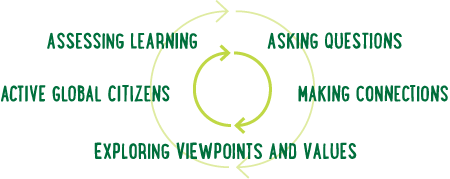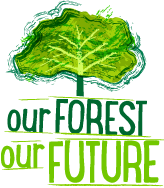How to use this resource...
Our Forest, Our Future helps teachers and pupils to explore the interdependence of people and forests and the vital role forests play in sustaining our environment – in the past, the present and hopefully the future.
The Scots Pine forests in Scotland and the Congo Basin rainforest in Africa provide case studies through which pupils will begin to understand why our forests are under threat and the implications for our planet. Further information about these forests is provided in the following documents.
In making connections between consumerism, people and the environment, pupils will be encouraged to see how they and their actions have an impact on the lives of others globally. It encourages reflection on the possible futures of the world's forests and ways of taking positive actions for a future where people and forests co-exist in a sustainable way.
The resource is structured around a global citizenship framework devised by Oxfam.
More detail on the framework can be found in Global Learning Framework [pdf]
The reflection and evaluation sections in each activity support formative assessment and ongoing monitoring of pupils learning.
Additional assessment opportunities are indicated by... 
Outdoor learning opportunities are indicated by... 
Homework activities are indicated by... 

Taking Action for Change
Education for Global Citizenship is committed to enabling pupils to bring about positive actions for change either locally or globally. This process should support pupils to make their own informed choices through a critical evaluation of the options open to them and the possible implications of those choices.
Throughout the resource there are ideas for possible actions, such as reflecting on our power as consumers, peer education and tree planting. Your pupils themselves should be encouraged to think creatively about the many actions they could take, critically evaluate the impact these actions might have and then evaluate what they have done.
The materials below support your pupils through this process.
> Exploring viewpoints and values
11. Whose forest? Land and rights in the Congo Basin rainforest
Aims
To investigate what it means to own something and different types of ownership
To reflect on who owns the land and the importance of land rights
To explore the challenges the Baka people face from a rights perspective
Part 1: Who Owns It?
What to do
Give each pair of pupils the who owns it? worksheet. Ask them to think of 5 things that:
- belong to them
- are shared with others
- are owned by the community
Each pair should then compare what they have written with another pair and talk about the similarities and differences.
Put the headings up and ask the class to share some of their responses. Discuss their ideas as a class using the teacher prompts.
Teacher prompts
- What is good about owning it?
- How can you prove you own it?
- How do you feel if someone else uses it?
- Are there some things that you own that you could share?
- Can people take it away from you? Why or why not?
- What can you do if someone takes it away from you?
- Discuss what it means to own something: e.g., you can sell it, let others use it, stop other people from using it, have to look after it, etc.
Ask pupils to look at what they own as part of the community and discuss what the benefits are of community ownership. Brainstorm what some of the benefits might be of a community owning the land where they live and work.
Explain that in many countries, including Scotland, a lot of the land that used to be shared by communities came to be legally owned by a few people, and as a result many people became landless What do you think might be the problem with a few people having control of most of the land?
Part 2: Land Rights – Human Rights?
What to do
Remind the pupils of the work done on rights and / or the Baka Community Lifestyle activity.
Read out the first part of the description of life in the forest from the Baka Community Lifestyle info sheet.
Ask pupils to think of how it might be to go and gather their food rather than go to the shops?
Do they have any experience of this? Berry picking or foraging for mushrooms and wild plants for example. Can you just get food in this way from anywhere?
Try to draw out from pupils that access to productive land is necessary to be able to do this. In Scotland you would need a licence to fish or shoot game and in many places you would have to pay the landowner to be allowed to gather edible plants.
Share the addition information from the Baka Community Lifestyle info sheet – except the last section: threats to the Baka people.
Brainstorm all the reasons why land is important to the Baka people.
- Plentiful food and nutrition
- Medicine
- Building materials for shelters and other uses
- Community space for social and cultural activity
- Emotional and spiritual connections
Finally share the information on the threats to the Baka people and discuss the points below.
Teacher prompts
- What are the consequences to the Baka people for being forced from the land?
- What will happen if they can’t go freely in the forest?
- Which of their rights are being denied?
- Is it fair that they can’t access the land?
The restraints on the Baka people are ever-growing as logging and other commercial activity grow and their rights and 'ownership' of land are being denied.
Reflection and evaluation
Ask pupils to look at the 'Users of the Forest' infographic. What do they notice? Who has most 'right' to use the forest? Who has least right? Why is there so much inequality in how the land is allocated?
Ask pupils their views about more land being allocated to protecting forest for wildlife than for people. Point out that most of the logging companies who have licences to exploit the forest are from the industrialised 'developed' countries
What does that say about who has the power in countries of the Congo Basin? Why do they think this is? Do they think this is fair and how things should be?
Extension
Some organisations are taking action on this injustice and pupils can research this.
Rainforest Alliance, Action Aid, PERAD, WWF and OKANI are working with the Baka in participatory projects which support the Baka to map their forest lands, connect with other Baka communities and claim their rights to live there. Other French NGOs (CEFAID and ORADOR) have been campaigning for the Baka to gain legal recognition as citizens.
These activities have been adapted by kind permission from www.onthelandwestand.org.uk
![]() Teacher info
Scots Pine forest [pdf]
Teacher info
Scots Pine forest [pdf] ![]() Teacher info
Congo Basin rainforest [pdf]
Teacher info
Congo Basin rainforest [pdf]
![]()
![]()
![]()
